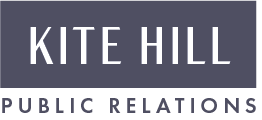Despite the collective level of “woke-ness” that has happened recently in business culture over the past year, insensitivities about racial and gender bias remain pervasive in workplace communication, in marketing and culture. Others may choose to believe it’s too late or too sensitive of a topic to care about, or it’s too thorny to actually take corrective action. At Kite Hill PR, we believe advancing progress in Diversity, Equity & Inclusion is not just a nice-to-do, it is an absolute business imperative and that we all have a role in taking steps toward accomplishing complete diversity and inclusion within our company and community.
Adopt an Inside Out Perspective
We start by offering perspective in our clients’ own PR programs. We are pleased that increasingly, the brands we work with realize that they need to start on the inside to ensure their own teams are diverse and that their actions invite inclusion from all across their employee and stakeholder base. Soliciting diversity in thought during discussions, taking in relevant perspectives and being receptive to new ideas from different backgrounds is not only a positive social move, it’s good business. Employees who believe their company’s inclusion strategy is strong are usually more engaged in the workplace – 61% of employees believe diversity and inclusion strategies are beneficial and essential.
Maintain an Agile Posture
Last year’s perfect storm of pandemic, racial and systemic injustice and political divide forced every industry, brand, and person to adapt and change their marketing and digital strategies. Advertisers discovered that personalization matters, but some brands misinterpreted this and instead, missed the mark and were more performative than socially conscious. “Inclusivity can help brands connect on a deeper, more meaningful level with their audiences – which can be a major asset to marketing campaigns,” said Hubspot’s Pamela Bump. And we agree.
Read The Room
At Kite Hill PR, part of our mission to help clients read the room and avoid showing up as performative. The road of good intentions is littered with missteps many brands made, whether it was Pepsi’s Kendall Jenner spot, Gucci’s Blackface jumper, or the H&M’s image that involved a young Black kid in a “Coolest Monkey in the Jungle” sweatshirt (and those are just a few). In today’s environment, marketing teams can always do better by actively listening to all stakeholders, by bringing in different perspectives and viewing Diversity, Equity & Inclusion as a long game, not a trend. Getting that wrong could lead straight to a brand being “cancelled.”
Diversity and inclusion can’t just start and stop at the marketing department, though. It starts at the core with the company’s mission, its leaders, and their values. Carmen Morris wrote in this Forbes piece,“In an era, in which social media and the internet dictates much of what your customers and employees talk about, being authentic and accountable for diversity and inclusion becomes an important issue for leadership.” Simply slapping a few people of color on a billboard, commercial, or magazine ad does not mean your company is genuinely and accurately practicing inclusive branding.
One thing that all of last year’s chaos taught us was that consumers are supporting brands that align with their core values and goals. Consumers want to feel “heard” and “connected” to the advertisements they are seeing on their screens. Brands that are actively speaking out and placing authentic ads are more likely to attract new consumers as opposed to brands that are staying silent. In fact, 69% of consumers would prefer to buy from brands committed to socially conscious causes. Everyone in the advertising industry, from agencies to advertisers to brands, has a responsibility to take a conscious approach to their strategies and it needs to start now.
Shania Roper, Account Associate
